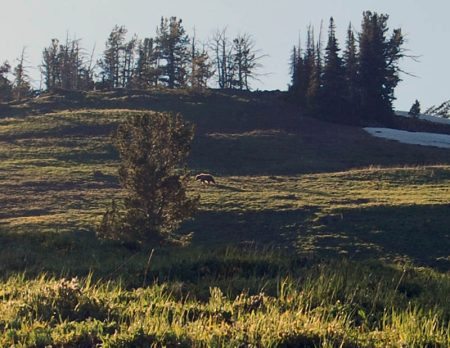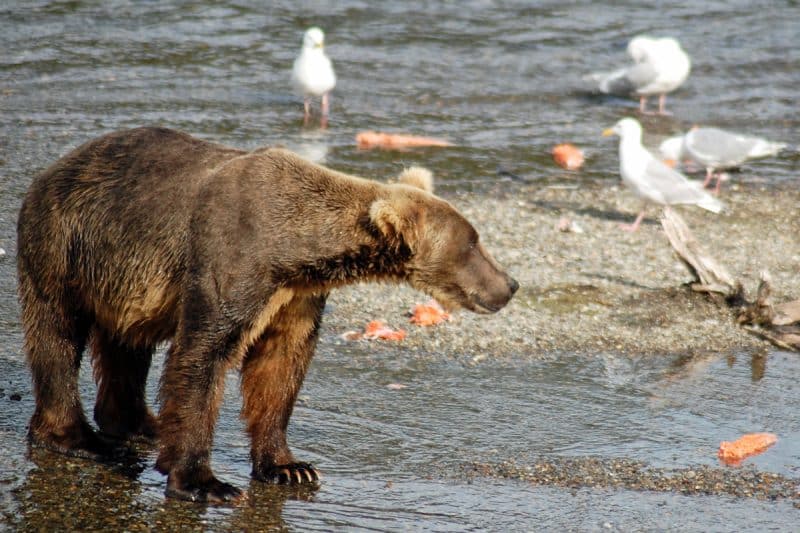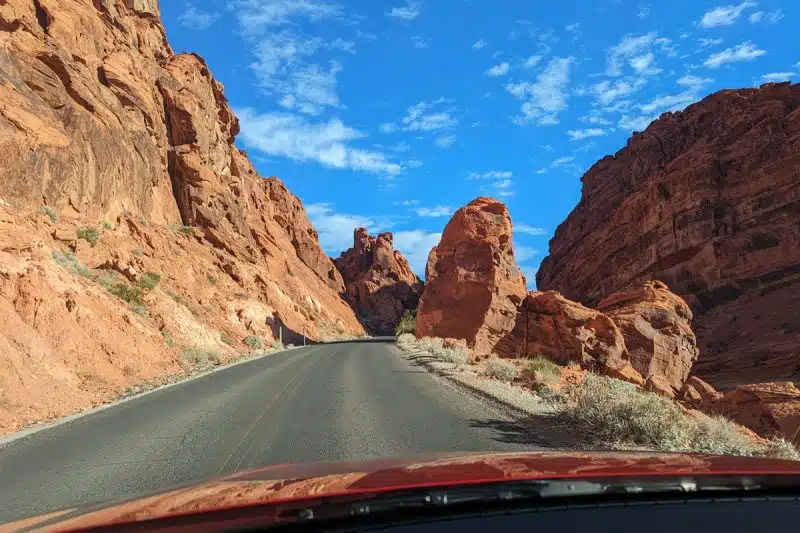
“Where can I see a bear in Yellowstone?”
The question probably made me sound like a newbie, but that’s ok, because I was. This was my first visit to Yellowstone National Park, years ago, and I was eager to see grizzly bears, bison, wolves, bighorn sheep and whatever else the park had to offer.
The ranger responded to my question with some suggestions, and I ended up seeing multiple bears during my visit. I’ve since returned to Yellowstone and have seen more than 20 bears there.
When it comes to seeing bears in Yellowstone National Park, we’ll be honest: It’s mostly luck. Most bear sightings happen when you’re driving through the park and happen upon a bear at the side of the road.
That said, there are some parts of Yellowstone that are more known for their black bear and grizzly bear activity. And the same is true of wolves, which are somewhat common in the park if you know where to look.
With that in mind, here’s our guide to the best places to see bears in Yellowstone. We’ve compiled this article based on our own multiple visits to the park over the years, as well as tips from rangers and the National Park Service.
In addition to bears and wolves, we’ll offer some tips for other Yellowstone wildlife you may want to see, such as moose, mountain goats, bighorn sheep, and more.

First Steps for Seeing Bears in Yellowstone
1. Learn the Yellowstone map
Yellowstone is really big. It’s bigger than the state of Rhode Island, in fact. So you can expect to do a lot of driving around the park.
The main roads form a figure 8 pattern. So people often refer to the “Upper Loop” and “Lower Loop” of the park roads.
Get familiar with where Lamar Valley and Hayden Valley are located, since those are two hotbeds of wildlife activity. Also learn about Mount Washburn and Dunraven Pass, which sit right in the heart of grizzly territory.
Here’s the official printable Yellowstone map from the NPS (PDF link.)
2. Speak with park rangers
Another obvious strategy is to stop into any or all of the visitor centers and chat with the rangers on duty.
They’re going to know where animals have been spotted in the previous few hours or days, so they’ll be your most reliable and current source of information.
On my last visit, rangers noted that a grizzly had been seen in the Lake Butte Overlook area. So I drove straight there and found a line of cars observing the grizzly just off the road. It was sleeping and not moving at all, but still fun to see!

3. Research recent wildlife sightings
These days, websites exist for just about everything. With sites such as yellowstone.co and yellowstonereports.com, you can read detailed reports from visitors who explain where they saw bears the day before. That can help you plan your itinerary.
These websites often use nicknames and shorthands in their reports. For instance, they might say “I saw a bear from Dave’s Hill yesterday,” and you might have no idea where Dave’s Hill is, since it’s not listed on park maps.
If you’re having trouble understanding the lingo used on these websites, download the Yellowstone SPOTR app, which has complete park maps with nicknames for every pullout and wildlife-watching area.
You can also download the AllTrails hiking app to read current reports for each hike in the park. Folks often see bears on the trails, and they mention them in their hiking reports.
4. Know what time of day is best
Bears and all major animals are most active during the early morning hours and the evening hours.
During the summer, sunrise in Yellowstone comes very early, around 5:30 am, and sunset doesn’t come until 9:30 pm.
If you want the best chance of seeing bears, start driving by 6 am. Most sightings happen between 6-9 am and 6-9 pm.
During the hot afternoons, bears are likely to sleep and hide out in the forest. Sightings still happen, they’re just less predictable.
5. Be prepared for encountering bears
Obvious disclaimer: Bears are dangerous. Don’t do anything stupid! Bring bear spray, hike with a partner, and keep a safe distance.
The park requires visitors to stay at least 100 yards away from large wild animals like bears. That’s the length of a football field.
Bears rarely attack and kill humans, but the frequency of attacks has been increasing — read more about this in our fun facts about Yellowstone post.
Map of the Best Places to See Bears and Other Wildlife
Take a look at this wildlife map for a cheat sheet. This is the best map of where to see bears, so you’ll want to download and save it to your phone.
This map has icons for grizzly bears, black bears, wolves, moose, elk, bison, pronghorn (antelopes), mountain goats, and bighorn sheep.
I didn’t create this map, but I can attest that it’s extremely accurate. Most of the animals I’ve seen in Yellowstone National Park have been found in those exact locations.
Where to See Bears in Yellowstone
Grizzly Bears
Both black bears and grizzly bears can be found anywhere throughout the park, but the map does a good job of highlighting the most likely areas.
Grizzly bears are most often seen in Lamar Valley and Hayden Valley, as well as higher elevations around Mount Washburn.
I saw one grizzly while hiking Mount Washburn, and two others from my car while driving through that area. Look up at the hillsides and out into the wide open meadows and valleys.

They’re also commonly seen in the Lake Butte and Avalanche Peak areas east of Yellowstone Lake, and in the western side of the Upper Loop, near the appropriately-named Grizzly Lake.
If you’re actually seeking to run into bears while hiking, and not just see them from your car, the Mount Washburn hike, the Grizzly Lake hike, and the Specimen Ridge hike in Lamar Valley are probably the three best hikes in Yellowstone for encountering grizzlies in the backcountry.
Black Bears
The map points out a black bear area around Roosevelt/Tower area, and another in the northwest near Mammoth Hot Springs. Those two areas are where I’ve seen most of the black bears during my Yellowstone visits.
For black bears, the trick is to drive back and forth between the Roosevelt area and Dunraven Pass, and keep looking into the forest.
Whenever there’s a line of cars, it means people have stopped to observe something. A traffic jam is the easiest way to spot wildlife in the park.
Keep an eye out, bring binoculars, and again, watch for cues from other visitors. Don’t be shy about going up to ask what they’re looking at!
I’ve also seen black bears just north of Old Faithful, on the edge of the trees near a parking lot. Several cars had gathered to watch a cub play in the trees.
Places to See Other Yellowstone Wildlife
Again this wildlife map is your best guide. Let’s run down some of the other big animals you’ll want to keep an eye out for, starting with the iconic wolves.
Wolves in Yellowstone
Near the park’s northeast entrance, Lamar Valley is the best spot for wolf watching. Wolves here may be black or gray in color.
That area is home to a lot of streams and flat, wide-open areas that wolves enjoy, as well as several turnouts where you can park and watch.
A regular group of wolf-watchers often gathers in these areas with high-powered telescopes. When I arrived, an onlooker allowed me to look through his scope to view a pack of wolves feasting on a dead bison.
Later, I was able to see wolves with my own eyes when two of them swam across a small stream, ran up the hill and crossed the street.

Often, the wolves are a mile or more from the main park road, so you will definitely want to bring binoculars to view them from a distance.
Drive the area between Slough Creek and Pebble Creek from 6-9 am and 6-9 pm, and you will almost certainly see plenty of wolf-watchers with their scopes.
In 2024, a wolf pack made a den near Slough Creek. It was about a mile off the road, but totally visible with binoculars or telescopes, so dozens of people gathered there every day to catch a glimpse of wolves coming in or out of the den.
Hayden Valley also has a wolfpack, and they are sometimes seen in the evenings running through the open fields.
Bison in Yellowstone
You can see bison pretty much everywhere in the park. On my first day in Yellowstone, I was driving through the west side of the park and saw a lone buffalo dozens of yards away.
It was the first time I’d seen one in the wild, so I excitedly created a parking space along the side of the road, got out, zoomed in, and took photo after photo.
Imagine how silly I felt just a few hours later, by which time I had seen literally hundreds of bison throughout the park, including some within five feet of my van.

You cannot visit Yellowstone without seeing bison, so don’t even worry about it. One of the most high-traffic areas for bison is in Hayden Valley, between Canyon Village and Fishing Bridge.
Don’t be surprised if bison cross the street right in front of your vehicle. Don’t get alarmed; just shut off the engine, and remain quiet.
I was fortunate enough to be on the road as a group of 50+ bison, including babies, made a road crossing. It was intense, since the animals are huge. But they crossed without incident.
If you’re lucky, maybe you’ll even see something like this.
Bighorn Sheep and Mountain Goats in Yellowstone
These animals are more rare. I didn’t see either during my first park visit, but on my 2024 return visit to Yellowstone, I saw both.
Bighorn sheep were visible through binoculars on a mountain ridge in Lamar Valley.
The sheep are most commonly seen there, and also near Dunraven Pass. I noticed sheep tracks in the dirt while hiking to Mount Washburn.
Mountain goats are generally found on the mountains near the Northeast entrance, but there’s a small population near Bunsen Peak on the western side of the Upper Loop.
In fact, while hiking Bunsen Peak, I heard the sound of rocks sliding, and looked over the see a single goat on the side of a cliff.

Moose in Yellowstone
Yellowstone has some moose, but they are smaller in numbers. You can sometimes see them around Yellowstone Lake and Grizzly Lake, in both small lakes and in the woods.
Moose are more common in bordering Grand Teton National Park. That park has many of the same animals as Yellowstone, but with smaller crowds! See our one day in Grand Teton itinerary for a suggested schedule.
Other Animals in Yellowstone

Elk are found throughout the park. They’re especially plentiful in the Mammoth Hot Springs area.
Elk look like deer, but they’re larger, have a darker brown complexion, and bright white butts. Male elk have a rack, but females are sometimes mistaken for deer.
Pronghorns are fast antelopes that are seen around the Roosevelt Lodge area and in Lamar Valley.
You’ll see pronghorn out there lying in the grass, just hanging out next to the bison.
Coyotes roam throughout the park. Lamar Valley and Hayden Valley are the hotspots, but I’ve seen coyotes on the Fairy Falls hike near Grand Prismatic Spring as well.
Marmots live in high elevation areas. They look like furry little woodchucks and love to eat flowers.
And finally, cute little prairie dogs live in Lamar Valley, on the Bunsen Peak trail, and on many other trails in the park.
They look a bit like squirrels, but they live in holes in the ground in big communities.
The greater Yellowstone ecosystem is one of the best places in North America to see wildlife. Enjoy your visit and good luck!
The summer months are the most common time to see wildlife, but Yellowstone is a great place for a winter trip as well. Wolves can be more easily seen against the white snow.
While this post is a good guide, you never know where you may see wildlife in Yellowstone. If you’re staying at a park campground or one of the Yellowstone Airbnbs in the area, you might have an elk or buffalo roam right through your yard!
Do you have any tips on where to see bears in Yellowstone (or other wildlife)?


